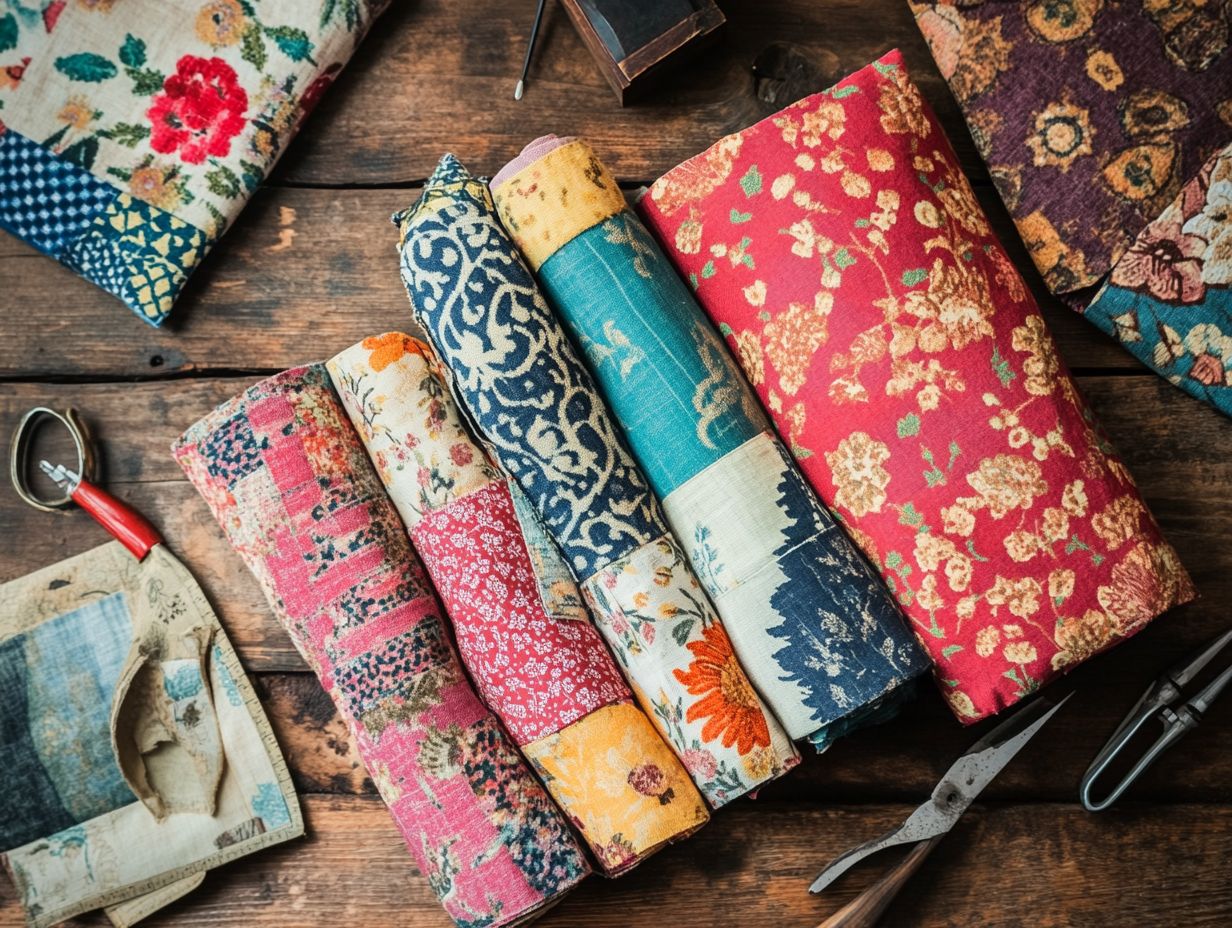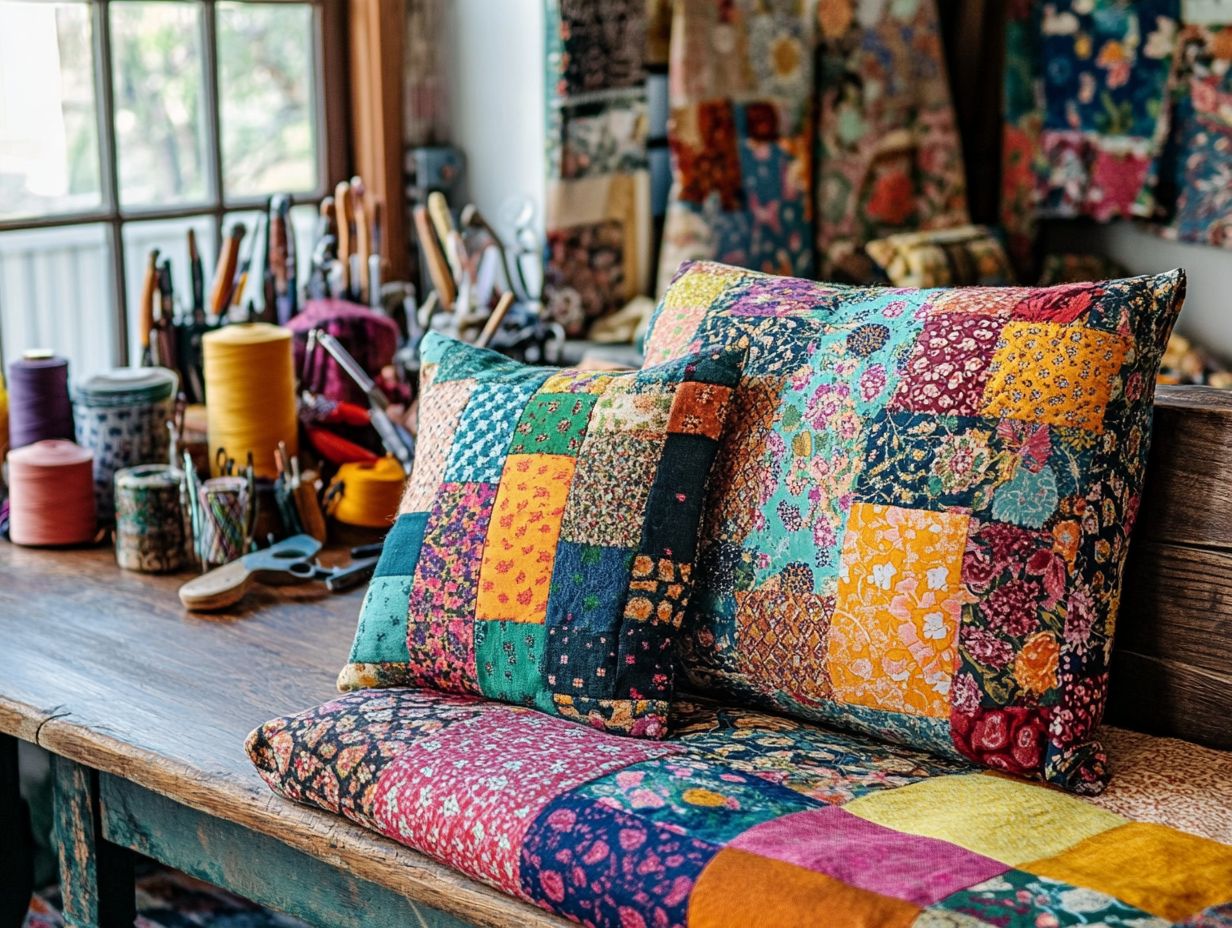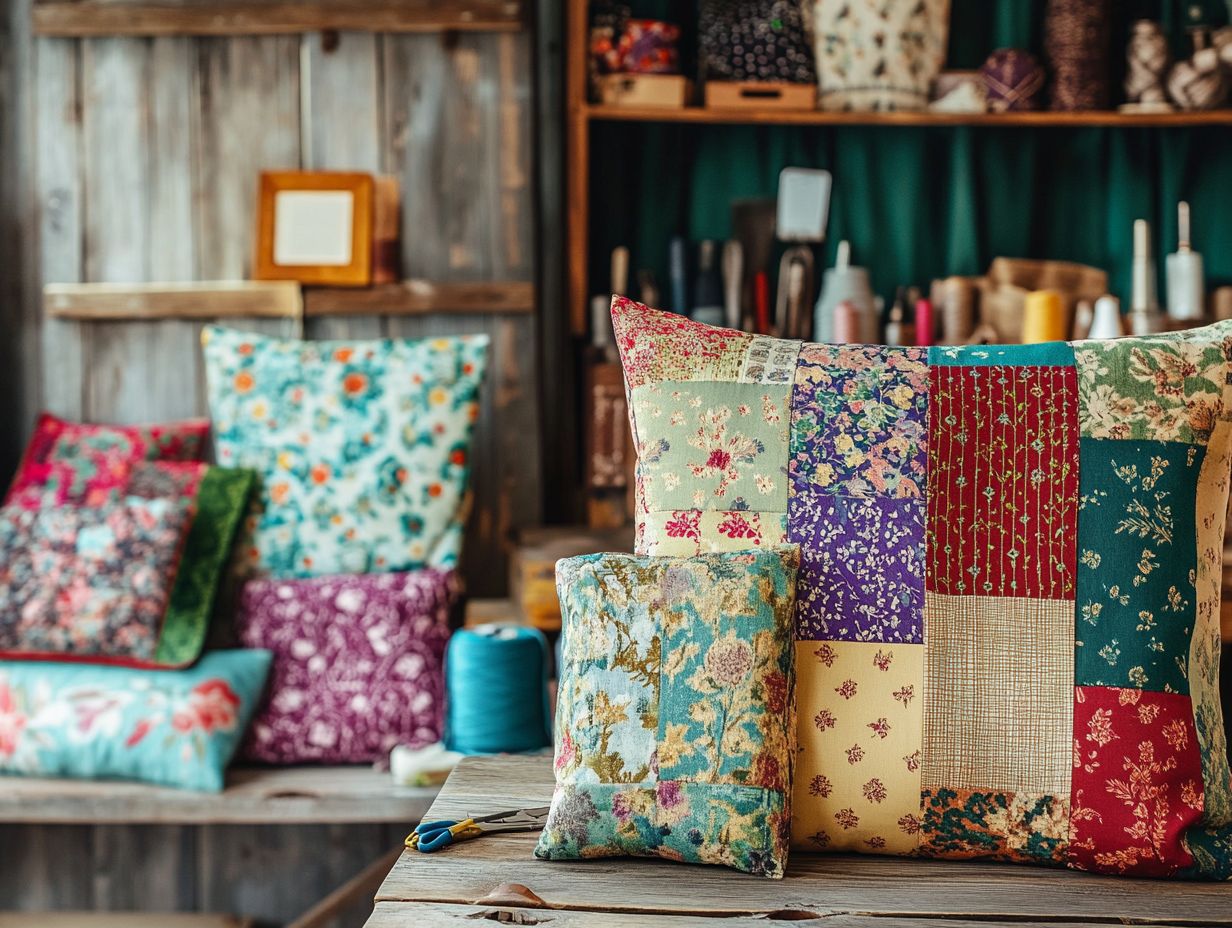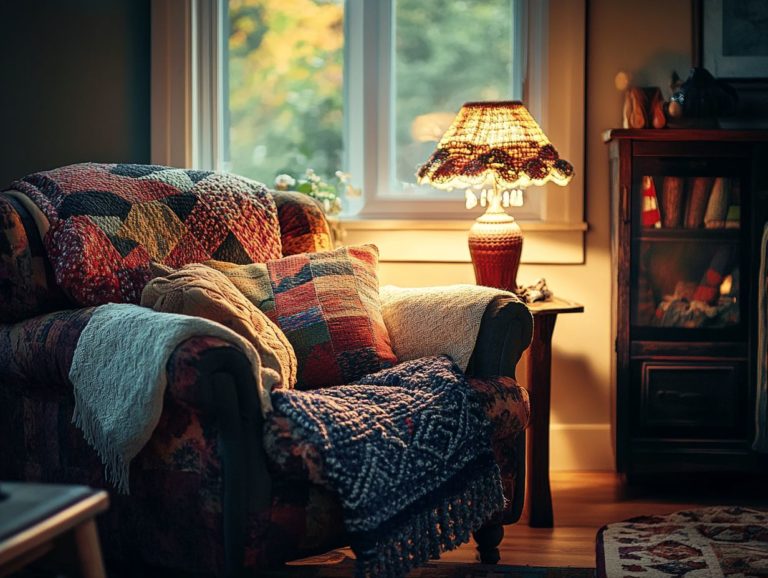5 Ways to Use Vintage Fabrics in Craft Projects
Are you seeking to infuse your crafting projects with a sense of nostalgia and creativity? Vintage fabrics present a world of possibilities, enabling you to weave character and history into your work.
Discover five innovative methods to transform vintage textiles into breathtaking creations, ranging from distinctive patchwork quilts to stylish accessories and elegant home decor.
You’ll also uncover valuable tips on sourcing and caring for these precious materials, ensuring your projects not only shine but also maintain their timeless charm.
Immerse yourself in the art of reimagining vintage fabrics!
Contents
- Key Takeaways:
- 1. Create a Unique Patchwork Quilt
- 2. Make a Statement with a Vintage Fabric Dress
- 3. Add Vintage Touches to Home Decor
- 4. Repurpose Vintage Fabrics into Accessories
- 5. Incorporate Vintage Fabrics into Mixed Media Art
- What Are the Best Places to Find Vintage Fabrics?
- Frequently Asked Questions
- What are some creative ways to use vintage fabrics in craft projects?
- Where can I find vintage fabrics for my craft projects?
- How can I incorporate vintage fabrics into my modern home decor?
- What are some tips for working with vintage fabrics in craft projects?
- How can I preserve the vintage look of the fabric in my crafts?
- Can I use vintage fabrics in other types of crafts besides sewing?
Key Takeaways:

- Add a touch of nostalgia to your home by incorporating vintage fabrics into your decor.
- Elevate your wardrobe with a statement piece made from a unique vintage fabric dress.
- Repurpose old fabrics and give them new life by creating one-of-a-kind accessories.
1. Create a Unique Patchwork Quilt
Creating a unique patchwork quilt is a rewarding endeavor that allows you to blend various pieces of vintage fabric. You can transform them into a beautiful antique quilt that tells a story and adds a personal touch to any room.
This creative project showcases your sewing skills and serves as a source of inspiration for upcycling, which means turning old materials into new, useful items.
The selection of vintage fabrics is an exhilarating first step. A visit to local thrift stores or flea markets can uncover treasures from decades past, like vibrant florals from the ’70s or subtle tones from the ’30s. Each piece often carries its own history, evoking memories or connections, such as a beloved grandmother’s tablecloth or remnants from a child’s cherished dress.
Once you ve chosen your fabrics, careful cutting and planning become essential. Consider using intricate techniques like log cabin or hexagon shapes to elevate your design. As the patches come together, your quilt will gradually reveal a vibrant tapestry of stories, enriching its aesthetic appeal and filling you with a sense of nostalgia and pride in crafting something unique.
2. Make a Statement with a Vintage Fabric Dress
Making a statement with a vintage fabric dress elevates your wardrobe and highlights your commitment to sustainable crafting. You can transform exquisite textiles into fashionable pieces that tell your story.
By carefully choosing vintage handkerchiefs or floral fabric, you can create stunning dresses that embody your individuality and style.
Incorporating various dress patterns, such as A-line, wrap, and shift designs, allows you to explore different silhouettes that beautifully complement the unique characteristics of your vintage fabric.
For a touch of whimsy, how about adding floral handkerchiefs as accents? You can use them as pockets or delicate overlays to enhance the overall aesthetic.
Mixing different textiles can yield a visually striking piece. Pairing sturdy cottons with softer laces or silks results in comfort without sacrificing style.
Ensuring that your dress allows for easy movement guarantees all-day comfort while making a distinctive and personal fashion statement.
3. Add Vintage Touches to Home Decor
Adding vintage touches to your home decor can instantly elevate the aesthetic of any space. It creates an inviting atmosphere that embraces the charm of thrifted finds and sustainable crafting.
From delightful fabric crafts like fabric-wrapped bangles to unique wall art made from vintage linens, there are countless ways to introduce nostalgic elements into your home.
How about crafting a magnetic memo board that tells your unique story? This not only serves a functional purpose but also showcases cherished vintage fabrics that evoke memories. Imagine using a grandmother’s old dress or a vintage tea towel each piece brimming with memories and a sense of history.
Alternatively, consider embellished pillows made from retro fabric to add a cozy yet stylish touch to your living room or bedroom.
By thoughtfully selecting specific vintage items, you can transform simple decor into rich narratives, inviting your visitors to appreciate the stories woven within each piece.
Get started on your vintage fabric projects today and let your creativity shine!
4. Repurpose Vintage Fabrics into Accessories

Repurposing vintage fabrics into accessories offers a delightful avenue for you to express your creativity while breathing new life into cherished materials. Each unique piece you create not only tells a story but also embodies a distinct personality. Whether you re crafting fabric hair bows, bowls, or knotted headbands, vintage fabric reflects your style and underscores a commitment to sustainable crafting.
To embark on this journey, start by gathering a selection of vintage fabrics that inspire you, alongside some essential sewing supplies think scissors, glue, and either a sewing machine or your trusty needle and thread.
A straightforward step-by-step process could look like this:
- Choose a fabric that resonates with you.
- Cut it to the desired size.
- Sew or secure it into your intended shape.
For example, hair bows can be adorned with various decorative items, while fabric bowls offer a canvas for different stitching techniques that elevate any decor. With a sprinkle of creativity, you can mix and match patterns and colors, crafting themed accessories for seasonal festivities or personal milestones. Each piece is a true original. If you want to dive deeper into this topic, check out our guide on decorating with vintage fabric: tips and tricks.
5. Incorporate Vintage Fabrics into Mixed Media Art
Incorporating vintage fabrics into your mixed media art opens up a realm of creative possibilities. You can blend various textures and colors, resulting in captivating artwork brimming with stories. Imagine techniques like embroidering on vintage linens or using fabric yarn to craft unique patterns these methods can elevate your mixed media projects to extraordinary artistic heights.
Merge these fabrics with paints, papers, and even found objects to create visually intriguing art. Picture using acrylic gel medium, a thick glue used in art to attach items, to elegantly attach delicate lace to a canvas or layering fragments of old quilts alongside modern prints. This effortlessly weaves nostalgia and freshness into a cohesive piece.
Equip yourself with fabric scissors, water-soluble markers, and a sewing machine to enhance your creative journey. This will enable innovative stitching and vibrant applications of color. The emotional resonance of working with vintage fabrics each a fragment of history can profoundly inform the narrative of your artwork. It invites viewers to connect with the past while engaging with the present.
What Are the Best Places to Find Vintage Fabrics?
Finding the best spots for vintage fabrics can be quite the thrilling adventure. Local thrift stores, antique markets, and online fabric sourcing platforms each hold unique treasures that ignite inspiration for your eco-friendly projects. Whether you’re on the hunt for handkerchiefs, linens, or flour sack fabric, the excitement of the search can lead you to delightful discoveries that elevate your sewing endeavors.
In those bustling local thrift shops, you ll be amazed at the charming patches and remnants hidden among crowded shelves, waiting for you to breathe new life into them. Antique markets, like the ones in the heart of Brooklyn or San Francisco s Ferry Building, often resemble treasure troves filled with old quilts and elaborate brocade waiting to be claimed.
When negotiating prices, starting with a friendly chat can work wonders; many vendors appreciate a good conversation and may be more open to offering a discount. Don t hesitate to scrutinize fabric quality keep an eye out for tightly woven threads and vibrant colors that suggest durability.
A friend once recounted a delightful tale of discovering an exquisite, hand-stitched tablecloth at a flea market. It not only became the centerpiece of her living room but also sparked countless creative sewing projects. Imagine the possibilities that await you on your own fabric-finding journey!
How Can One Care for Vintage Fabrics?
Caring for vintage fabrics is crucial. It helps preserve their beauty and ensures they last a long time.
You’ll need specific care instructions to maintain the integrity of treasured items like antique linens and handcrafted sewing projects. By understanding how to clean, store, and protect vintage fabric properly, you’ll keep these cherished pieces vibrant and functional for years to come!
Avoid harsh detergents. Instead, opt for gentle cleaners that won t harm delicate fabrics. Hand-washing is often the safest method. If you must machine wash, use a delicate cycle with cold water. Always air dry fabrics away from sunlight to prevent fading and deterioration.
For storage, consider using acid-free tissue paper and breathable cotton bags. This way, you can protect your textiles from moisture and pests while keeping them in a cool, dark place to preserve their historical essence.
By being mindful of these practices, you ll keep your vintage fabrics looking beautiful for years!
What Are Some Tips for Combining Different Vintage Fabrics?

Combining different vintage fabrics can be a delightful challenge! A solid grasp of color theory the way colors interact with each other and design principles is essential for crafting harmonious and visually captivating projects.
To achieve a successful blend, start with a primary color palette that reflects the mood or theme you wish to convey. For example, pairing soft pastels with darker hues can create a striking contrast, while colors that are next to each other on the color wheel, like blues and greens, can evoke a sense of tranquility.
Patterns also play a pivotal role in your design. Mixing florals with stripes can add depth and dimension, but tread carefully to avoid overwhelming the overall look. Subtle textures can enhance visual interest while maintaining cohesion.
Ultimately, thoughtful design choices harmonize your fabric selections and enrich the entire project, resulting in a cohesive and captivating final piece.
How Can Vintage Fabrics Add a Personal Touch to Projects?
Vintage fabrics can infuse your projects with a profound personal touch, as each piece carries its own history and offers an emotional connection that new materials simply can t match!
Choosing a vintage fabric for a quilt, for instance, might evoke cherished memories of a grandmother’s home, flooding you with nostalgia that modern materials simply lack. Each patch tells a story, reminiscent of the time you spent rummaging through estate sales, uncovering snippets of the past. Perhaps one swatch transports you back to a beloved childhood dress, inspiring a fresh twist on that vintage aesthetic.
By sewing with such fabrics, you forge an emotional connection with your projects, crafting pieces that resonate deeply with both you and their future owners. Imagine the stories each piece tells! Incorporating vintage textiles for DIY projects into your creations not only makes them unique but also connects you to the past.
What Are Some Creative Ways to Use Vintage Fabrics?
Exploring creative ways to use vintage fabrics offers fun projects, ranging from practical fabric crafts to whimsical DIY creations that celebrate sustainability and your unique style. By repurposing these materials, you can craft items like fabric-covered clipboards, reusable makeup wipes, and even distinctive floor poufs that harmonize style with functionality.
Each project invites a surge of creativity, allowing for personal expression and the joy of making things. To embark on your journey, gather basic sewing tools, adhesive spray, and an assortment of vintage fabrics in various textures and patterns. For a delightful idea, check out how to create a vintage fabric scrapbook.
Imagine making a patchwork quilt: simply gather your scraps, cut them into squares, and sew them together. You’ll create a cozy keepsake that tells your story. Alternatively, you can upcycle old clothes into chic tote bags or charming aprons with just a few straightforward stitches.
The possibilities are limitless. Each project offers a chance to delve into vibrant colors and textures, making crafting an experience that is both fulfilling and delightful.
What Are Some Common Mistakes When Working with Vintage Fabrics?
Working with vintage fabrics can present distinct challenges, but being mindful of common mistakes can improve your sewing results. From improper care to misjudging the fabric’s integrity, navigating the intricacies of vintage textiles is vital for preserving your hard work and ensuring lasting results.
To avoid pitfalls, carefully examine the fabric before diving into a project. Some materials may possess weakened fibers that simply won’t stand up to heavy handling. Washing methods are equally important opting for gentle cycles or hand washing can help prevent further damage.
As you embark on vintage sewing, select patterns that align with the fabric’s unique characteristics. To enhance your projects, consider how to decorate with vintage fabric trims. Always experiment with new techniques on scraps first. These practices not only safeguard the integrity of each piece but also equip you with the knowledge necessary for future endeavors. This will help refine your sewing skills and bolster your confidence in working with these cherished textiles.
Frequently Asked Questions

What are some creative ways to use vintage fabrics in craft projects?
- Patchwork quilts
- Embroidered wall hangings
- Fabric-covered journals
- Vintage fabric flowers
- Fabric-covered frames
Where can I find vintage fabrics for my craft projects?
You might discover vintage fabrics at local thrift stores, flea markets, garage sales, and online platforms like Etsy or eBay. You can also repurpose old clothes or linens to use as fabric in your projects.
How can I incorporate vintage fabrics into my modern home decor?
Vintage fabrics can add a unique and cozy touch to your modern home decor. Use them to make throw pillows, table runners, curtains, or even cover old furniture pieces.
What are some tips for working with vintage fabrics in craft projects?
When working with vintage fabrics, it’s important to handle them with care as they can be delicate. You may need to pre-wash them to remove any stains or odors. Also, use sharp scissors and a sewing machine needle suitable for delicate fabrics.
How can I preserve the vintage look of the fabric in my crafts?
To preserve the vintage look, you can use techniques such as distressing, tea staining, or using vintage-inspired patterns and designs. Mixing and matching different vintage fabrics can help create a cohesive and unique look.
Can I use vintage fabrics in other types of crafts besides sewing?
Yes, vintage fabrics can be used in a variety of crafts, not just sewing. You can use them in scrapbooking, decoupage, jewelry making, and even mixed media art. The possibilities are endless!
Start your DIY projects with vintage fabrics today!






